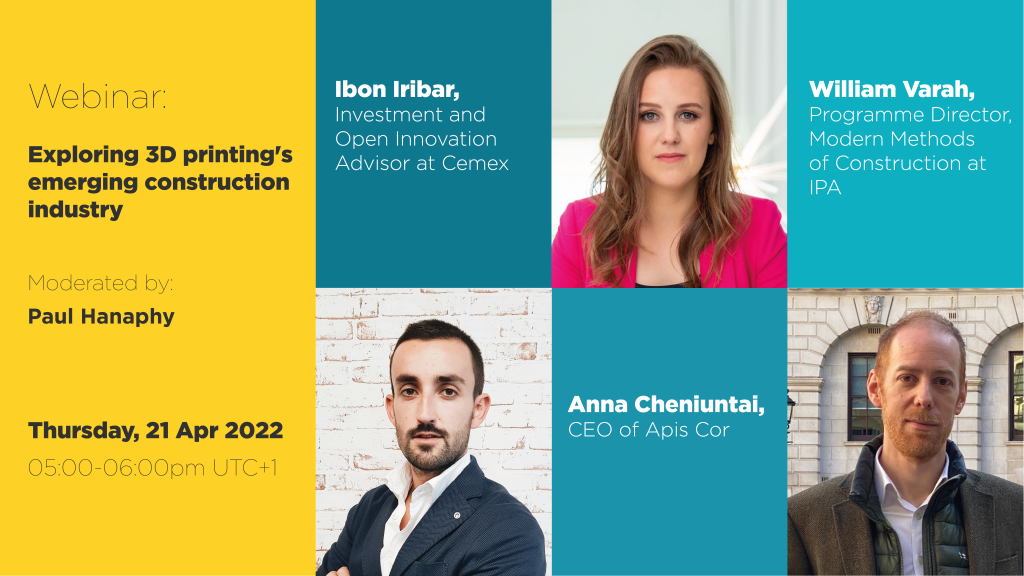For those inside the 3D printing bubble, you’d be forgiven for thinking that the technology has already made significant inroads into the wider construction sector.
Over the last year alone, one-off builds ranging from BAM and Weber Beamix’s 3D printed bridge to WASP’s 3D printed Dior store have made headlines across the globe, generating a huge amount of hype around the process’ potential. This fanfare has also brought those developing such technologies to the attention of investors, thus the likes of ICON have now raised north of $460 million in funding.
One such firm, that’s seeking out start-ups is CEMEX Ventures, the investment arm of building material specialist CEMEX. However, speaking ahead of the upcoming ‘Exploring 3D Printing’s Emerging Construction Industry’ webinar, in which he’s set to share his insights on the technology, CEMEX Ventures’ Investment & Open Innovation Advisor Ibon Iribar has raised some caveats to its construction potential.
“One of the benefits of 3D printing is the improved speed and reduced time that you need to print something, but what’s not being talked about so loudly, is the time you need to take the machine to a specific site,” explained Iribar. “With a robotic arm, it’s also easier to print something from scratch with ground that isn’t level, but using a gantry system, you need the ground to be levelized as much as you can.”
“That’s what these companies are effectively selling when they say, you can build more affordable housing for those on low-income,” he added, “it’s more for developing projects from scratch in ‘standardized’ sites.”

Seeking out 3D printing start-ups
Founded in 2017, CEMEX Ventures works specifically to identify trends with the potential to benefit the activities of its parent firm and the wider construction industry. In doing so, the business unit has begun tracking the progress of many emerging technologies, including 3D printing, which Iribar says has come on leaps and bounds over the last five years.
“We have talked with almost every early-stage 3D printing start-up in this space, and what we have seen is that there has been a clear evolution,” said Iribar. “Five years ago, everyone was trying to develop gantry or robotic arm-based systems. We detected that the hardware part was going to be covered soon but the material side was still pending to be dealt with. So that’s why we decided to enter this space.”
In its efforts to advance concrete 3D printing, CEMEX Ventures has sought to not just work with entrepreneurs, but those already with a foothold in the sector, as a means of validating the technology’s capabilities. One way the firm has managed to achieve this, is via its partnership with construction additive manufacturing specialist COBOD, which has previously built several houses around the world.
Thus far, the companies’ collaboration has seen them develop a new fast-setting 3D printing concrete that reportedly gains shape ‘instantaneously,’ and deployed it to construct a house in Angola. Since then, the firms have also managed to erect the world’s largest building 3D printed from ‘real concrete’ in Oman, and Iribar says there’s plenty more potential left in the admixture-boosted material.
“While we are working with them to develop the first version of the ‘D.fab’ material, we are also trying to explore how CEMEX can be useful in aiding the distribution and spread of 3D printing projects at a global scale,” added Iribar. “This is not only in Europe, but in Latin America, the US, North America and the Middle East, and the latter is a very hot space for 3D printing right now.”
“We think that developing projects in the Middle East would be key to showing other potential markets that this technology is ready to jump to the next stage.”

Challenging concrete assumptions
However, while Iribar says that CEMEX Ventures has observed an improvement in the scale and finish that construction 3D printing technologies are able to achieve in recent years, he also acknowledges its remaining challenges. When it comes to the reported cost benefits of concrete 3D printing over traditional construction technologies, for instance, the CEMEX advisor says these aren’t always clear-cut.
“Although it [3D printing] is much cheaper than traditional building methods, if you are targeting the low-income segment, in most cases they still cannot afford it when you take into account the cost of finishing,” explained Iribar. “This is because the market is just starting to jump from that demo level to a more commercial level. But we are currently at some point in between.”
Though Iribar asserts that “3D printing isn’t going to replace traditional building methods” any time soon, he suggests that it can achieve “a significant market share” in the longer-term. To help emerging concrete 3D printing developers realize the potential of their technologies, the CEMEX advisor explains that government funding would help, but his employers are also working to facilitate this via partnerships.
According to Iribar, such collaborations are key to driving the technology towards its inflection point, as too many firms are currently trying to cover material and machine development as well as contracting. By instead establishing cross-sector ‘alliances,’ he says that construction start-ups not only stand to improve the quality of their buildings, but amplify the other benefits 3D printing is promoted as having.
“If an entrepreneur or company in the construction industry is willing to approach us in order to explore opportunities on projects around 3D printing, we are more than happy to open our doors,” concluded Iribar. “Since developing a marketable product with the D.fab material, we have also started to come up with new versions of the product, so we’re very happy to start conversations on developing something.”

Forecasting construction 3D printing’s future
Iribar is set to elaborate on his views alongside a band of fellow construction and 3D printing experts in the now-imminent webinar entitled: ‘Exploring 3D printing’s Emerging Construction Industry.’ Scheduled to take place from 5-6pm BST on Thursday April 21, 2022, the event will see 3D Printing Industry’s own Paul Hanaphy lead a discussion on the technology’s benefits, challenges and future in the sector.
Other webinar participants are set to include William Varah, Programme Director of Modern Methods of Construction at the UK government’s Infrastructure and Projects Authority (IPA), as well as Anna Cheniuntai, CEO of Apis Cor, a firm which specializes in 3D printing houses, and recently began trading shares in the US.
Those interested in attending the Exploring 3D printing’s Emerging Construction Industry event can sign-up for the webinar here.
Manufacturers keen on working with CEMEX Ventures, meanwhile, can either apply to take part in its construction start-up competition, or contact the firm directly.
To stay up to date with the latest 3D printing news, don’t forget to subscribe to the 3D Printing Industry newsletter or follow us on Twitter or liking our page on Facebook.
For a deeper dive into additive manufacturing, you can now subscribe to our Youtube channel, featuring discussion, debriefs, and shots of 3D printing in-action.
Are you looking for a job in the additive manufacturing industry? Visit 3D Printing Jobs for a selection of roles in the industry.
Featured image shows the experts set to take part in 3D Printing Industry’s Exploring 3D Printing’s Emerging Construction Industry webinar. Image via 3DPI.


